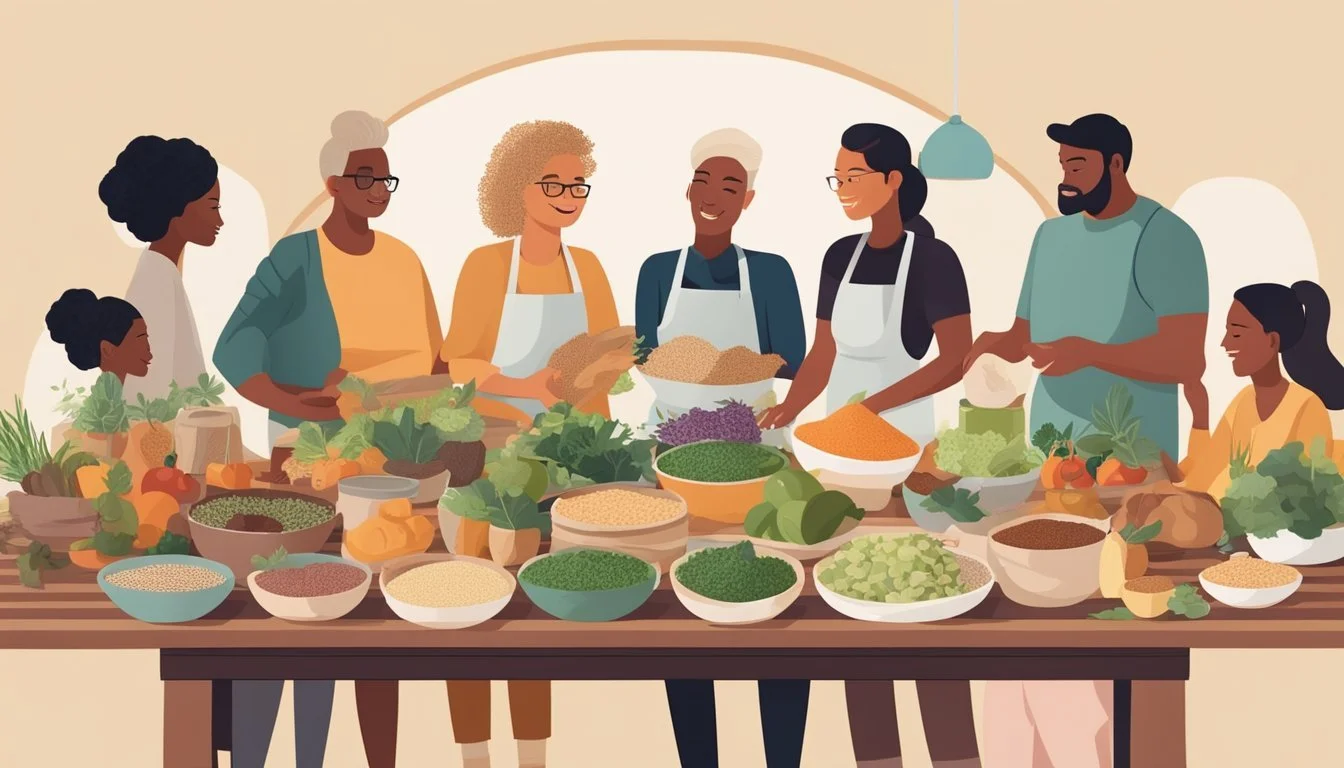Building a Supportive Community for Your Grain-Free Journey
Keys to Success
Embarking on a grain-free lifestyle can be a pivotal step towards holistic health. It often requires not only dietary changes but a shift in mindset and daily habits. The transition to a grain-free diet may initially seem challenging given the prevalence of grains in conventional eating patterns. However, support from like-minded individuals can significantly ease this journey. A community of individuals who share the same wellness goals can provide encouragement, share recipes, and offer practical tips for maintaining a grain-free lifestyle.
Sustaining a grain-free lifestyle involves more than just eliminating wheat, barley, rye, and other grains from one's diet; it encompasses understanding food labels, finding suitable substitutions, and developing new cooking skills. Access to a supportive community becomes invaluable as one navigates this terrain. Whether it’s through social media groups, local meet-ups, or partnerships with health coaches and nutrition experts, building a network of support can contribute to a successful and enjoyable grain-free journey.
The collective wisdom of a community can empower individuals to stay committed to their wellness goals. By exchanging ideas and learning from each other's experiences, people embarking on a grain-free path can discover innovative ways to enrich their diets with nutritious, grain-free options. Rather than a restrictive experience, the grain-free lifestyle, backed by community support, becomes an exploratory and fulfilling endeavor that prioritizes health and well-being.
Embarking on a grain-free journey can be made even more rewarding and fulfilling when you have a supportive community by your side. By connecting with like-minded individuals, sharing experiences, and seeking out valuable resources, you can build a strong and encouraging network to enrich your grain-free lifestyle.
The latest grain-free science research has shed light on the benefits of reducing grains in our diet, particularly for individuals with grain-free digestive disorders. By joining a supportive community, you can gain insights, tips, and encouragement from others who may have similar health concerns and dietary goals.
Building a grain-free kitchen pantry is easier and more enjoyable when you have a supportive community to share recipes, shopping tips, and meal ideas with. Discovering new grain-free flour alternatives and navigating grain-free hidden grains labels becomes a collaborative effort, making the journey more manageable and exciting.
For pet owners, a supportive community can also provide valuable advice and recommendations for grain-free pet products and recipes, ensuring that your furry companions can also thrive on a grain-free diet.
Exploring grain-free international cuisine with a community of fellow enthusiasts can open up a world of culinary inspiration and cultural exchange, making your grain-free journey even more diverse and enjoyable.
By fostering a supportive community, you can enhance your grain-free journey, celebrate successes, overcome challenges, and create lasting connections with others who share your passion for a healthy and fulfilling grain-free lifestyle.
Benefits of a Grain-Free Lifestyle
Adopting a grain-free lifestyle may contribute to various aspects of health and wellness, from gut health to mental well-being. These benefits can be crucial for individuals with specific dietary needs or health goals.
Improving Gut Health
A grain-free diet can lead to improved gut health. Removal of grains, especially those containing gluten, can aid in reducing digestive discomfort for people with sensitivities, and promote a balanced gut microbiome that is conducive to the growth of healthy probiotics.
Weight Loss and Management
For many, a grain-free diet supports weight loss and management. Grains are often high in carbohydrates that can contribute to weight gain. By eliminating grains, individuals may find it easier to achieve a calorie deficit and maintain a healthy weight balance.
Enhanced Overall Health
This diet may bolster overall health by encouraging the consumption of more nutrient-rich foods like fruits, vegetables, meats, and nuts, potentially leading to improved nutrient intake and better health outcomes.
Increased Energy Levels
Grains can cause fluctuations in blood sugar levels, which affects energy. Going grain-free may stabilize these levels, leading to increased and more consistent energy, which is essential for exercise and daily activities.
Reducing Inflammation and Allergies
Grain-free lifestyles can help reduce inflammation and alleviate symptoms of food allergies and certain autoimmune disorders, as grains can be inflammatory for some individuals.
Supporting Mental Health
Diet plays a role in mental health. A grain-free diet might mitigate stress and promote mental well-being by stabilizing blood sugar and reducing inflammation, which are factors that influence mood and cognitive function.
Benefits for Specific Diets
A grain-free approach is often inherent in paleo, primal, and keto diets. It matches their emphasis on whole, unprocessed foods and can be an effective strategy for those looking to follow these specific nutritional protocols for better health.
Planning Your Grain-Free Journey
Embarking on a grain-free lifestyle requires thoughtful planning to ensure it aligns with individual health goals and is sustainable long-term. Success hinges on setting achievable objectives, creating a tailored plan, and smart budgeting.
Setting Realistic Health Goals
One's health journey begins with setting realistic goals. Whether it's improving energy levels, managing a health condition, or losing weight, goals should be specific, measurable, and time-bound. A two-week timeline for initial targets, for example, can pave the way for longer-term success.
Creating a Customized Grain-Free Plan
Designing a customized plan involves choosing nutrient-rich, real foods that substitute grains. Legumes and pseudocereals like quinoa and buckwheat can offer a variety of recipes for meals, ensuring balance and satisfaction. Incorporating these alternatives can make the transition smoother and more enjoyable.
Budgeting for a Grain-Free Diet
A grain-free diet doesn't have to break the bank. Budgeting effectively means prioritizing expenses and finding cost-effective substitutes. Almond flour and coconut flour, while pricier, are used sparingly and can be balanced against savings from bulk-purchased legumes and seasonal produce.
Building a Grain-Free Pantry
Stocking the pantry with the right ingredients is crucial. Essential items include:
Almond and coconut flour: For baking and thickening sauces
Nuts and seeds: For snacking and adding to dishes
Legumes: A versatile protein source
Healthy fats: Such as olive or avocado oil
This prepares one for success in creating satisfying grain-free meals.
Meal Planning and Preparation Tips
Efficient meal planning involves setting a time to prep and cook, which can significantly impact the selection of recipes. Opt for easy-to-make recipes if time is limited and batch-cook to save time and reduce stress. Keeping a variety of recipes handy prevents mealtime monotony.
Navigating Challenges and Setbacks
Setbacks are inevitable on any diet journey. It is essential to anticipate possible challenges and strategize ways to overcome them. Build a supportive community; sharing experiences and tips can alleviate stress and reinforce commitment to a grain-free lifestyle.
Maintaining Nutritional Balance
Ensuring a balanced diet while avoiding grains involves a focus on a variety of foods that provide essential nutrients. Embracing legumes, tofu, tempeh, and edamame ensures protein intake, while leafy greens and colorful vegetables offer vital vitamins and minerals to maintain balance and health.
By adopting these actionable steps, anyone can confidently plan and navigate their grain-free journey with the assurance that they can maintain a balanced, affordable, and fulfilling lifestyle.
Community and Support Networks
Transitioning to a grain-free lifestyle can be challenging, but a robust community and support network can significantly ease the process. These networks provide resources, motivation, and valuable insights that can guide individuals on their grain-free journey.
Finding Local and Online Grain-Free Communities
Grain-free communities exist both locally and online, offering resources and camaraderie. Local groups may be found through health food stores or community boards. Online, social media platforms such as Facebook and Instagram host grain-free groups where members share tips, recipes, and support.
Facebook Groups: Search for "grain-free living" to find communities.
Instagram Hashtags: Follow #grainfree to connect with like-minded individuals.
Engaging with Supportive Friends and Family
The support of friends and family is invaluable. Communicating one's goals and dietary needs can foster understanding and create a supportive home environment. Involving them in meal planning and preparation can also strengthen relationships and provide a shared sense of achievement.
Meal Sharing: Host grain-free dinners to integrate support.
Educational Outings: Visit grain-free-friendly venues together.
Collaborating with a Health Coach or Nutritionist
Professional guidance from a health coach or nutritionist specializing in integrative nutrition can personalize one's grain-free journey. They can provide tailored advice, accountability, and educate on the relationship with food and its impact on health.
Accountability: Regular check-ins with a health coach can maintain motivation.
Personalized Plans: Nutritionists can create meal plans catering to individual needs.
Learning from Blogs and Articles
Blogs and articles are excellent resources for education and inspiration. Many offer success stories, testimonials, and a wealth of information on the science behind grain-free living and its benefits.
Informational Blogs: Read from experts in grain-free and integrative nutrition.
Success Stories: Gain motivation from the experiences of others.
Success Stories and Testimonials
Testimonials can be powerful motivators. Hearing success stories from individuals who have thrived on a grain-free diet reinforces the potential benefits and can serve as a roadmap for others.
Websites: Look for grain-free lifestyle sites with a testimonial section.
Community Forums: Engage in discussions and share experiences to inspire and be inspired.
Nutritional Insights and Education
When adopting a grain-free diet, it's crucial to understand the nutritional landscape, the body's reaction to grains, and the importance of protein to maintain a balanced diet.
Understanding Grain-Free Nutrition
A grain-free diet eliminates all grains and may encompass a variety of nutrient-rich foods to ensure a balanced intake of vitamins and minerals. Such a diet often includes:
Fruits and vegetables: Vital sources of vitamins, antioxidants, and fiber.
Nuts and seeds: These provide healthy fats and proteins.
Animal products: Eggs, dairy, meat, and fish can be rich in protein and essential fatty acids.
Nutritionists emphasize the importance of variety to make up for nutrients commonly found in grains.
Health Impacts of Grains on the Body
Grains can impact digestion and inflammation. For individuals with sensitivities or intolerances, grains may lead to:
Digestive discomfort: Such as bloating or gas due to difficulty in digesting certain grains.
Inflammation: Certain grains are believed to cause inflammatory responses in some people.
Understanding individual reactions to grains is essential in a grain-free lifestyle for maintaining overall digestive health and reducing unwanted inflammation.
Role of Protein in a Grain-Free Diet
Protein is vital for tissue repair and muscle health, especially when grains are absent from the diet. A variety of protein sources are recommended to ensure adequate intake:
Animal Proteins: Including meat, fish, poultry, and dairy - provide complete protein with all essential amino acids.
Plant-Based Proteins: Such as legumes and soy - can be included for those who prefer or require a vegetarian or vegan approach.
Ensuring proper protein intake supports metabolism, muscle health, and overall well-being on a grain-free diet.
Finding Grain-Free Alternatives and Substitutes
Transitioning to a grain-free lifestyle requires discovering new staple ingredients and learning how to incorporate them into daily meals and snacks. This section will guide readers through selecting grain-free baking essentials, cooking with healthy fats and oils, choosing natural sweeteners, and opting for nutrient-dense foods.
Grain-Free Baking Essentials
For grain-free baking, coconut flour and almond flour are indispensable. Keep in mind that coconut flour is highly absorbent and typically requires a quarter cup to a third cup to replace one cup of grain-based flour. Adjusting the number of eggs and liquids like coconut milk is often necessary for optimal results. Almond flour offers a slightly nutty taste and is used in a one-to-one ratio with traditional flour for most recipes. Including baking powder and baking soda without added grains ensures proper rise and texture in baked goods.
Cooking with Healthy Fats and Oils
Using coconut oil and olive oil in cooking introduces essential fatty acids that support overall health. Coconut oil can be a versatile substitute for butter in grain-free recipes, adding to the flavor and moisture of the dish. Olive oil is ideal for both cooking and dressing options, providing a heart-healthy fat that complements a variety of meals. Nut butters, such as almond or sunflower seed butter, can also be used as flavorful thickeners in sauces and condiments.
Sweetening without Sugars and Grains
Choosing natural sweeteners over refined sugars and grain-based sweeteners can effectively reduce sugar cravings while adhering to a grain-free diet. Maple syrup and stevia are great options for imparting sweetness without the addition of grains. Maple syrup provides a rich, complex flavor in baked goods and desserts, while stevia is a calorie-free sweetener suitable for drinks and selected recipes. The key is to use these sweeteners sparingly and be mindful of the overall sugar content in the diet.
Choosing Nutrient-Dense Snacks and Meals
Nutrient-dense snacks and meals are foundational for a successful grain-free journey. Snacks like homemade nut butter mixed with celery sticks or apple slices offer satisfying alternatives to grain-based options. Meals should focus on incorporating a balance of vegetables, lean proteins, and healthy fats to ensure a well-rounded nutrient profile. Simple swaps like using lettuce wraps instead of bread or grain-free tortillas can transform traditional meals into grain-free ones without sacrificing taste or nutrition.
Lifestyle Integration Tips
Embracing a grain-free lifestyle requires integrating new habits that support one's physical and mental well-being while maintaining an active social life. The following subsections provide actionable strategies to incorporate this way of living holistically.
Incorporating Exercise and Physical Activity
They can enhance their grain-free journey by weaving regular exercise into their routines. Activities like running and yoga not only improve cardiovascular health but also complement dietary changes by advancing overall health and creating a sense of balance. For example:
Running: Simple to start, can be enjoyed outdoors or on a treadmill, and effective at burning calories.
Yoga: Increases flexibility, reduces stress, and can be practiced at different intensity levels.
Mindfulness and Stress Management
Stress can sabotage even the healthiest lifestyles, making mindfulness a crucial part of one's routine. Techniques such as deep breathing, meditation, or sipping herbal tea can help maintain a calm and focused mind, setting a solid foundation for making thoughtful food choices.
Meditation: Just 10 minutes a day can significantly reduce stress levels.
Tea: A variety of herbal teas offer calming properties without disrupting a grain-free diet.
Clean Eating and Organic Choices
Adopting a grain-free diet is more sustainable when intertwined with clean eating and choosing organic foods. They should prioritize:
Real Food: Fresh vegetables, fruits, lean proteins, and healthy fats.
Organic: Whenever possible, opting for organic to reduce exposure to pesticides and chemicals.
Clean eating enhances the benefits of a grain-free diet by removing processed items and focusing on whole foods that are more nutrient-dense.
Maintaining a Social Life While Grain-Free
Navigating social scenarios while maintaining a grain-free lifestyle calls for preparation and communication. They can sustain their relationships and social life by selecting restaurants with grain-free options or hosting dinner parties that showcase delicious grain-free recipes.
Dining out: Research menus in advance and don't hesitate to ask for modifications.
Social Gatherings: Offer to bring a grain-free dish, making it easier to adhere to dietary choices.
Each individual can maintain their social connections and enjoy a rich social life without compromising their grain-free commitments.
Overcoming Common Obstacles
Adopting a grain-free lifestyle can lead to significant health benefits, but it also introduces a variety of challenges. Tackling these head-on with preparation and confidence is essential for a smooth transition and sustained adherence to the diet.
Dealing with Social Pressures
One often encounters social pressures when adopting a grain-free diet. To maintain confidence and withstand peer pressure, individuals can educate friends and family about their dietary choices, emphasizing the health benefits. Planning ahead for social events by bringing grain-free options or eating beforehand can alleviate the stress of maintaining dietary restrictions in a social context.
Eating Out and Travel Challenges
Eating out and traveling can pose difficulties for those on a grain-free diet. Individuals should review menus in advance and communicate dietary restrictions to servers or chefs with clarity. When traveling, packing non-perishable grain-free snacks and researching restaurants that cater to grain-free options are key strategies to ensure compliance with dietary restrictions.
Managing Cravings and Temptations
Grain-free individuals often face cravings and temptations for prohibited foods. Developing self-control is crucial. They should keep a variety of grain-free snacks available and remind themselves of their health goals. Including new, flavorful grain-free recipes in their meal plan can also decrease the feeling of missing out on traditional grain-based foods.
Financial Considerations of a Grain-Free Diet
A grain-free diet may impact one's budget due to the higher cost of some substitutions and specialty items. Budgeting effectively is essential. They can buy in bulk, choose seasonal produce, and opt for less expensive protein sources like legumes (if not also following a paleo or keto diet) to mitigate costs. Planning meals around sales and seasonal offerings can also lead to financial savings.
Time Management for Meal Prepping
Meal prepping requires time, which can be scarce. They can allocate specific times for meal preparation during the week to manage this challenge efficiently. Batch cooking and using a slow cooker can save time, and having a clear meal plan for the week can streamline the process, ensuring that time spent in the kitchen is both effective and minimal.
Resources and Tools for Grain-Free Living
Embarking on a grain-free journey can be straightforward with the right resources and tools. This section is dedicated to providing readers with trusted brands, insightful cookbooks, and effective tracking methods to support a grain-free lifestyle.
Recommended Grain-Free Brands and Products
Brands and Products:
Deeks: Offers a variety of grain-free bread, pasta, and cakes, shipping Australia-wide.
Nom Nom Paleo: A brand that is celebrated for its grain-free recipes and resources.
It’s important for consumers to look for transparency in ingredient sourcing and to consider any personal dietary restrictions when selecting products.
Cookbooks and Recipe Blogs
Cookbooks and blogs are essential for diversifying one's diet and staying inspired. Here are a couple of recommendations:
Cookbooks:
"Against All Grain" by Danielle Walker
"The Grain-Free Family Table" by Carrie Vitt
Recipe Blogs:
Grain Free Living: Personal blog with a compilation of recipes and resources.
Nom Nom Paleo: Features a wealth of grain-free recipes suitable for the whole family.
Tracking Progress and Milestones
Journaling: Keeping a food diary can be incredibly beneficial for tracking progress on a grain-free diet. It helps in identifying which foods are most beneficial and those that may trigger negative responses.
Milestones: Celebrating milestones, such as the first month grain-free or the first successfully baked grain-free bread, is essential for motivation. Consider using apps or calendar reminders to recognize these achievements.
Conclusion
In the journey towards maintaining a grain-free diet, individuals often experience a significant transformation that encompasses both personal and communal dimensions. Embracing this lifestyle necessitates a dedication to continuous learning and community support, which are vital for sustaining long-term success and wellness.
Realizing Long-Term Success in a Grain-Free Lifestyle
For one to realize long-term success in a grain-free lifestyle, it is imperative to integrate the diet into one's daily routine. Consistency is key – regular meal planning and consistent dietary habits fortify the path to wellness. Individuals often find strength in numbers; hence, joining or creating a supportive community provides the encouragement necessary to overcome challenges. Such communities offer shared experiences, recipes, and strategies that help in maintaining a grain-free lifestyle.
Continued Education and Growth
Ongoing education and growth are fundamental components of any wellness journey. Those committed to a grain-free lifestyle must become adept at reading food labels, understanding nutritional content, and keeping abreast of the latest grain-free products and alternatives. They should also remain informed about pertinent research and developments in grain-free nutrition. This process of continual learning not only empowers individuals with knowledge but also fosters a culture of growth within their supportive communities.









